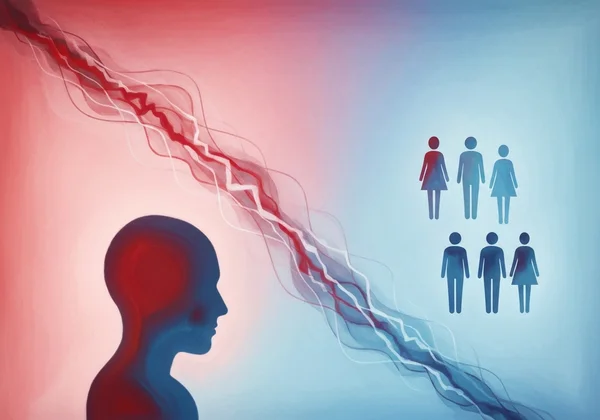PHQ-9 for Adolescents: Teen Depression Screening Guide
Navigating the emotional landscape of adolescence can be challenging for both teens and their parents. It's a time of immense change, and it's often difficult to distinguish between typical teenage moodiness and something more serious. As a caregiver, you want to provide support, but it's not always clear where to start. This is where a tool like the Patient Health Questionnaire-9 (PHQ-9) can be incredibly valuable. So, is PHQ-9 reliable for teen depression screening? Yes, when used correctly, it can be a powerful first step.
This guide is designed to help you understand how to use the phq9 for adolescents in a sensitive and effective way. We will explore how depression can look different in teens, how to approach the conversation, and what to do with the results. By the end, you'll have a clearer path to supporting your teen's mental well-being, starting with a simple, confidential screening you can explore together. Taking this initial step can open the door to meaningful conversations and, if needed, professional support. You can start the assessment on our platform anytime.

Understanding the PHQ-9 for Youth Mental Health
The PHQ-9 is a clinically validated questionnaire used worldwide to screen for the presence and severity of depressive symptoms. While originally designed for adults, it has been proven effective for adolescents, offering a structured way to check in on their emotional health. It consists of nine questions that align with the diagnostic criteria for major depressive disorder, asking about experiences over the past two weeks.
Using this tool for youth mental health isn't about labeling or diagnosing; it's about listening. It provides a common language to discuss feelings that can be hard to articulate. It transforms vague concerns like "my teen seems down" into specific observations, such as difficulty sleeping or a loss of interest in hobbies. This clarity is the first step toward understanding and action.
How Teen Depression Manifests Differently
One of the biggest hurdles in recognizing teen depression is that it doesn't always look like profound sadness. While adults might express feelings of hopelessness, a teenager's depression can often be masked by irritability, anger, or frustration. They might lash out, withdraw from family, or experience a sudden drop in grades.
Other common signs in adolescents include:
- Persistent Irritability or Anger: More than just occasional moodiness, this is a constant state of being on edge.
- Social Withdrawal: Suddenly losing interest in friends or activities they once loved.
- Physical Complaints: Frequent headaches, stomachaches, or other pains that have no clear medical cause.
- Extreme Sensitivity to Rejection: Feeling worthless or devastated by minor criticism or perceived slights.
Understanding these nuances is crucial because the PHQ-9 questions can help identify these hidden symptoms, providing a more complete picture of what your teen is experiencing.

Is PHQ-9 Suitable for Your Teen's Age Range?
A common question from parents is about the appropriate phq 9 age range. Clinical research supports the use of the standard PHQ-9 for adolescents aged 12 and older. For this age group, the questions are generally well-understood and the scoring remains a reliable indicator of depressive symptoms. There is also a modified version, the PHQ-A (Adolescent), which rephrases some questions to be more teen-centric, but the standard nine items are still considered the core of the screening.
The most important takeaway is that the PHQ-9 is a screening tool, not a diagnostic one. A high score doesn't automatically mean your teen has depression, and a low score doesn't rule it out. It is simply a snapshot of their recent emotional state—a conversation starter to be shared with a healthcare professional like a pediatrician or a mental health specialist. You can use our confidential screening tool as a starting point.
Guiding Your Teen Through the PHQ-9 Assessment
Approaching your teen about a mental health screening requires care and sensitivity. The goal is to make them feel supported, not interrogated. Framing the PHQ-9 as a "check-up for your feelings," similar to a regular physical, can help normalize the experience and reduce any potential stigma.
Before you begin, it’s essential to set the stage for an open and honest dialogue. The environment in which you have this conversation matters just as much as the words you use.
Creating a Safe Space for Open Conversation
Find a time when you are both calm and have privacy, free from distractions. Avoid bringing it up during an argument or when you're in a rush. Start the conversation by expressing your love and concern in a non-judgmental way.
You could say something like, "I've noticed you haven't seemed like yourself lately, and I care about you. I found this simple, private questionnaire that helps people understand their feelings better. Would you be open to looking at it together, or maybe on your own?"
Assure them that their answers are confidential and that the goal is simply to understand what they're going through. Your role is to be a safe harbor, a place where they can be vulnerable without fear of judgment.

Supporting Your Teen as They Answer the Questions
When your teen agrees to take the PHQ-9, your role is to be a supportive presence. Let them answer the questions on their own to ensure the responses are genuine. However, you can be available to clarify what a question means if they ask.
Pay special attention to question number nine, which asks about thoughts of self-harm or suicide. This question is a standard and vital part of the screening. If your teen indicates they have had these thoughts, it is critical to stay calm and take it seriously. Thank them for their honesty and assure them you will get them help immediately. This is not a moment for panic, but for direct, supportive action.
Interpreting PHQ-9 Scores & Next Steps for Teens
Once the questionnaire is complete, you will receive an instant score. This number is a guide—a piece of information that helps you decide on the next steps. It’s crucial to discuss the results with your teen in a way that feels empowering rather than alarming.
The score provides a measure of symptom severity, but it doesn't tell the whole story. The context of your teen's life, their personal struggles, and their strengths are all part of the bigger picture.
What Your Teen's PHQ-9 Score Means
Understanding the phq 9 score meaning is straightforward. The scores are typically categorized into severity ranges:
- 0-4: Minimal or no depressive symptoms.
- 5-9: Mild depressive symptoms.
- 10-14: Moderate depressive symptoms.
- 15-19: Moderately severe depressive symptoms.
- 20-27: Severe depressive symptoms.
Instead of focusing on the label, focus on the implications. A score in the mild range might suggest a conversation about stress management or lifestyle changes. A score in the moderate to severe range indicates a clear need to connect with a professional. Use the score as evidence to support your teen, saying, "This helps me see how much you've been struggling. Let's find someone who can help." You can understand your score further on our platform.
When to Seek Professional Support for Adolescent Depression
Knowing when to escalate your concerns is key. You should seek professional support for adolescent depression if:
- The PHQ-9 score is 10 or higher (in the moderate to severe range).
- Your teen answers anything other than "not at all" to question #9 about self-harm.
- The symptoms, regardless of the score, are interfering with their daily life (school, friendships, family relationships).
- Your parental intuition tells you that something is wrong.
Start by making an appointment with your teen's pediatrician or family doctor. They can conduct an initial evaluation and provide a referral to a mental health specialist, such as a therapist, psychologist, or psychiatrist.
Essential Resources & Crisis Support for Youth Mental Health
If your teen is in immediate danger or expresses active suicidal thoughts, do not wait. Your first priority is their safety. There are dedicated resources available 24/7 to provide crisis support for youth mental health.
- National Suicide Prevention Lifeline: Call or text 988 in the US and Canada.
- The Crisis Text Line: Text HOME to 741741.
- The Trevor Project: Call 1-866-488-7386 or text START to 678-678 for LGBTQ youth.
- Go to your nearest emergency room or call 911.
Keep these numbers accessible. Ensuring your teen knows these resources exist can be a lifeline in a moment of crisis.

Empowering Your Teen's Journey Towards Mental Wellness
Using the PHQ-9 for your adolescent is more than just a screening; it's an act of love and a commitment to their well-being. It opens a door to communication and shows your teen they don't have to navigate their difficult feelings alone. Remember, the goal is not to fix them, but to empower them with understanding, support, and the right professional resources.
This journey towards mental wellness is a marathon, not a sprint. By taking this first, informed step, you are planting the seeds for resilience, self-awareness, and a healthier future. We encourage you to use our free online test as a private and supportive resource to begin this important conversation today.
Common Questions About PHQ-9 for Adolescents
What age group is PHQ-9 used for?
The standard PHQ-9 is clinically validated and widely used for individuals aged 12 and older. It is a reliable tool for screening depressive symptoms in the adolescent population and guiding decisions about further evaluation.
Is PHQ-9 reliable for teen depression screening?
Yes, numerous studies have shown that the PHQ-9 is a reliable and valid tool for screening for depression in adolescents. While it cannot diagnose depression, its accuracy in identifying symptoms makes it an excellent first step for parents and clinicians to determine if a professional evaluation is needed.
Can PHQ-9 diagnose depression in adolescents?
No, the PHQ-9 is strictly a screening tool, not a diagnostic instrument. A formal diagnosis of depression can only be made by a qualified healthcare professional, such as a psychiatrist, psychologist, or physician, after a comprehensive evaluation. The PHQ-9 results are a valuable starting point for that professional conversation.
How often should a teen take the PHQ-9?
If symptoms are a concern, the PHQ-9 can be used as an initial baseline. A healthcare provider might recommend repeating it every few weeks or months to monitor symptom changes or track progress during treatment. For a general check-in, it can be used whenever you have concerns about your teen's emotional state.
What is a positive PHQ-9 score for a teenager?
A score of 10 or higher is generally considered a "positive" screen, indicating that moderate depressive symptoms are present and a follow-up with a healthcare professional is strongly recommended. However, any positive response (anything other than "not at all") to question #9 about self-harm should be treated as a positive screen requiring immediate attention, regardless of the total score. You can get your results on our site to see where your teen's score falls.